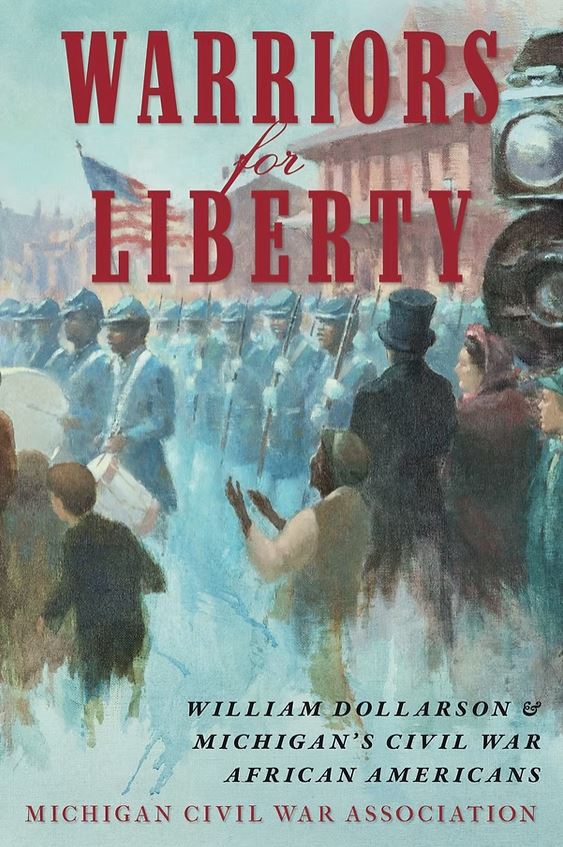Book Review: Warriors for Liberty: William Dollarson & Michigan’s Civil War African Americans

 Warriors for Liberty: William Dollarson & Michigan’s Civil War African Americans. Edited by Jack Dempsey. Traverse City, MI: Mission Point Press, 2024. Hardcover, 320 pp. $24.95.
Warriors for Liberty: William Dollarson & Michigan’s Civil War African Americans. Edited by Jack Dempsey. Traverse City, MI: Mission Point Press, 2024. Hardcover, 320 pp. $24.95.
Reviewed by Tim Talbott
When students of the Civil War are asked to name a northern state and its contributions to emancipation and Black Civil War service, one of the immediate answers that probably comes to mind is Massachusetts due to Boston’s active role in harboring and assisting freedom seekers, as well as its active and early role in raising the well-known 54th and 55th infantry regiments, along with the 5th Colored Cavalry. Others may identify Ohio, with its Underground Railroad networks, assiduous activists like John Parker and Charles and John Mercer Langston, and the progressive spirit found in some of the Buckeye State’s towns and places of Black higher education like Oberlin and Wilberforce College. Ohio also sent two African American units into service, the 5th and 27th United States Colored Infantry regiments. Pennsylvania is yet another. African American freedom advocates like Philadelphia’s William Still and Robert Purvis, and Pittsburg’s Martin Delany all championed abolition and equality. Additionally, the Keystone State ended up offering ten United States Colored Infantry regiments to the war effort: the 3rd, 6th, 8th, 24th, 25th, 32nd, 41st, 43rd, 45th, and 127th.
Perhaps a state that may not immediately come to mind is Michigan. However, with the recent publication of Warriors for Liberty: William Dollarson & Michigan’s Civil War African Americans, edited by Jack Dempsey for the Michigan Civil War Association, its place among those mentioned above is finally receiving the attention it has long deserved.
Published 160 years after Michigan’s only Black regiment mustered into service, Warriors for Liberty provides readers with important stories organized into four topical parts. Before diving into them though, the book offers a scene-setting preface by Brian James Egan, who serves as president of the Michigan Civil War Association; an inspiring and thought-provoking forward on freedom by the president and executive director of the Detroit River Project, Kimberly Simmons; and an instructive introduction by Dempsey.
Part one, “A Culture of Liberty in a New Northern State,” consists of two brief sections that explain Michigan’s settlement, road to statehood in 1837, and early abolitionist activism. Three months after Michigan joined the Union, an interracial group formed the Detroit Anti-Slavery Society, with the goal of ending slavery in the United States and promoting “the elevation of our colored brethren to their proper rank as men.” (8) Also discussed is Michigan’s long history of assisting enslaved individuals on Underground Railroad networks and active opposition to federal fugitive slave laws.
Part two, “William Dollarson: From Virginia to Michigan,” consists of three sections and offers a fascinating biography of a man who was born enslaved in King George County, Virginia, sold at age 18 to a Richmond slave trader, and then forcibly transported to Mississippi. Dollarson fled slavery via river systems and eventually landed in Detroit in 1836. Becoming a well-admired chef in Detroit, he was also an active conductor in Michigan’s Underground Railroad network. Not allowed to serve as a soldier when war broke out, and likely too old anyway, Dollarson still wished to contribute toward a cause he surely hoped would end in the abolition of slavery, so he offered his talents and served as cook for Gen. Alpheus Williams and his staff in Virginia. Despite the hardships imposed on an old man through military campaigning, labor-intensive duties, and the potential dangers of capture and re-enslavement, Dollarson contributed to the Union effort through his humble, yet important efforts until the summer of 1862, when he returned home after doing his part in the cause.
“The Riot of 1863” serves as the book’s third topical part. Despite having a sizable anti-slavery and pro-war population, Michigan also had a considerable number of anti-war Democrats who wished to have the nation reunited upon its pre-war basis. The enactment of the recent Emancipation Proclamation’s set some Democrats on edge. The riot occurred on March 6, 1863, when a mixed-race man was charged with sexually assaulting a Black girl and a white girl. A furious mob attempted to take out their anger on Black workers at a nearby cooper shop. Resisting the attack, the mob grew angrier and also attacked adjacent Black dwellings. The mob beat Black men, women, and children, stole property, and damaged houses and shops by throwing rocks, smashing possessions, and arson.
It was within this contentious atmosphere that the 1st Michigan Colored Infantry (later re-designated at the 102nd United States Colored Infantry) began recruiting a few months later. The fourth part, “The 1st Michigan Colored Regiment” tells their story over two sections from their formation to transfer to the Department of the South and their eventual participation in several skirmishes and battles, primarily in South Carolina.
An extended appendix covering over 20 fascinating items of interest related to Michigan’s Civil War-era African Americans provides readers with additional information. Footnotes throughout the book, and a thorough bibliography both illustrate the depth of research that went into Warriors for Liberty. A fine section of “Illustrations” in the middle of the book helps readers visualize and better understand some of the people and topics discussed throughout the text.
Warriors for Liberty serves as an excellent model for other similar state organizations to follow. Studies like this one for other Midwestern states like Indiana and Illinois, who sent limited numbers of regiments due to their small Black populations, would only enhance our knowledge and show a likely broader than previously imagined effort and participation among Civil War-era African Americans’ to end slavery and preserve the United States of America.
As a Michigander I am definitely going to have to pick this book up.